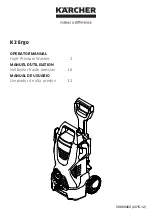
For technical questions, please call 1-800-444-3353;
troubleshooting section at end of manual.
SKU 99741
PAGE 4
ing outlets will reduce risk of electric
shock.
Avoid body contact with grounded
2.
surfaces such as pipes, radiators,
ranges and refrigerators. There is an
increased risk of electric shock if your
body is grounded.
Do not expose pressure washers to
3.
rain or wet conditions. Water enter-
ing a pressure washer will increase
the risk of electric shock.
Do not abuse the cord. Never use
4.
the cord for carrying, pulling or un-
plugging the pressure washer. Keep
cord away from heat, oil, sharp edges
or moving parts. Damaged or entan-
gled cords increase the risk of electric
shock.
gFcI PrecautIOnS
5.
Test GFCI (Ground Fault Circuit Inter-
rupter) before each use as follows:
Plug GFCI into power outlet and
a.
press reset button. Indicator
should turn on.
Press test button. Indicator should
b.
turn off.
Press reset button again for use.
c.
Do not use if above test fails.
The GFCI device does not protect
against electrical shock due to con-
tact with both circuit conductors or a
fault in any wiring supplying the GFCI
device.
to allow gFcI unit to function
properly, extenSIOn cOrdS
muSt nOt be uSed with this
pressure washer.
Personal safety
Stay alert, watch what you are do-
1.
ing and use common sense when
operating a pressure washer. Do not
use a pressure washer while you are
tired or under the influence of drugs,
alcohol or medication. A moment of
inattention while operating pressure
washers may result in serious per-
sonal injury.
Use personal protective equipment.
2.
Always wear eye protection and thick
rubber boots. Safety equipment such
as dust mask, non-skid safety shoes,
hard hat, or hearing protection used
for appropriate conditions will reduce
personal injuries.
Prevent unintentional starting. Ensure
3.
the switch is in the off-position before
connecting to power source and/
or battery pack, picking up or carry-
ing the equipment. Carrying pres-
sure washers with your finger on the
switch or energizing pressure wash-
ers that have the switch on invites
accidents.
Do not overreach. Keep proper foot-
4.
ing and balance at all times. This
enables better control of the pressure
washer in unexpected situations.
Dress properly. Do not wear loose
5.
clothing or jewelry. Keep your hair,
clothing and gloves away from mov-
ing parts. Loose clothes, jewelry or
long hair can be caught in moving
parts.
Only use safety equipment that has
6.
been approved by an appropriate
standards agency. Unapproved
safety equipment may not provide
adequate protection. Eye protection
must be ANSI-approved for the spe-
cific hazards in the work area.





































